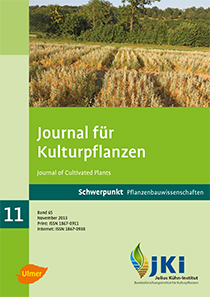Do soybean inoculants differ in their inoculation efficacy?
DOI:
https://doi.org/10.5073/JfK.2013.11.01Keywords:
Soybean, Bradyrhizobium japonicum, inoculant, inoculant quality, nodulation, nodule size, varietal differences, inoculationAbstract
Soybean seed usually needs to be inoculated in Germany to guarantee the development of symbiosis between soybean and Bradyrhizobium japonicum. In practice, inoculants that are available in Germany often seem to differ in the effectiveness of symbiosis, which may lead to fluctuation in yield and thus for farmers to uncertainty in the choice of a suitable inoculant. For this reason, different rhizobial inoculants available on the German market were tested for efficacy under standardized conditions in a short-term pot experiment in a greenhouse at the University of Hohenheim. The tested inoculants were Force 48, NPPL HiStick, RhizoFlo, NPPL Microgranulés, Radicin N° 7 and the pre-inoculated seed “Fix Fertig”. The tested crop varieties were Merlin, Primus and Cordoba.
Significant differences were observed between the inoculants in the number of nodules formed and the nodule biomass per plant. The average number of nodules per plant ranged from 5 for the least effective to 143 for the most effective inoculant, and depended on the plant variety. Many nodules were consistently formed in treatments with Force 48, RhizoFlo and NPPL Microgranulés whereas the number of nodules was low after treatments with Fix Fertig or Radicin. The nodule biomass per plant (0.17 to 0.40 g) was also dependent on the inoculant and the plant variety. The lowest nodule biomass per plant was produced by the soybean variety Merlin inoculated with Radicin, and by Primus inoculated with NPPL Microgranulés. There was positive correlation between nodule biomass and aboveground biomass production for cv. Merlin.
A plausible reason for differences in the nodulation could be the different amount of rhizobium cells in the inoculants. Furthermore, the formulation and additional adhesives could have affected the infection rate of B. japonicum. A long storage time between inoculation and sowing might additionally have led to a low infection rate for pre-inoculated seed.
A classification of nodules in 14 size classes from ≤ 1.0 mm to ≥ 7.1 mm diameter showed that formation of large nodules partially compensates for a small number of nodules per plant. Principally, the differences observed in the field also occurred in this pot experiment. The amount of rhizobium cells in the initial inoculant and at time of sowing seem to be important parameters that can affect the efficacy of the product. These quality aspects are adjustable. Further optimization of inoculation should consider specific interactions between soybean varieties and strains of rhizobia.
Downloads
Published
Issue
Section
License
The content of the journal is licensed under the Creative Commons Attribution 4.0 License. Any user is free to share and adapt (remix, transform, build upon) the content as long as the original publication is attributed (authors, title, year, journal, issue, pages).
The copyright of the published work remains with the authors. The authors grant the Journal of Cultivated Plants, the Julius Kühn-Institut and the OpenAgrar repository the non-exclusive right to distribute and exploit the work.







